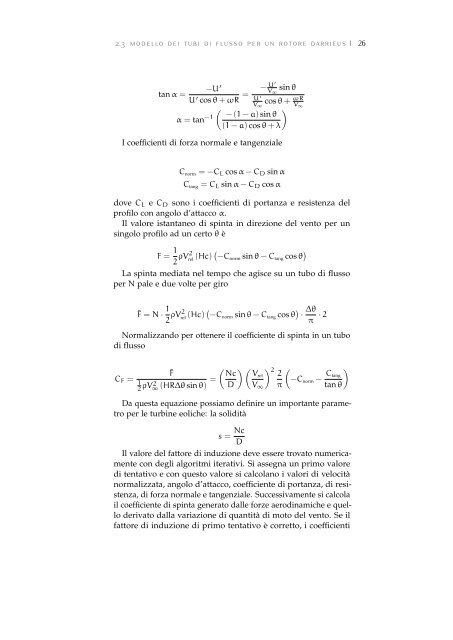Analisi numerica di una turbina eolica ad asse verticale - Atomino FVG
Analisi numerica di una turbina eolica ad asse verticale - Atomino FVG
Analisi numerica di una turbina eolica ad asse verticale - Atomino FVG
Create successful ePaper yourself
Turn your PDF publications into a flip-book with our unique Google optimized e-Paper software.
2.3 MODELLO DEI TUBI DI FLUSSO PER UN ROTORE DARRIEUS 26<br />
U′ − sin θ V∞ =<br />
−U<br />
tan α =<br />
′<br />
U ′ cos θ + ωR U ′<br />
ωR cos θ + V∞ V∞<br />
α = tan −1<br />
<br />
− (1 − a) sin θ<br />
(1 − a) cos θ + λ<br />
I coefficienti <strong>di</strong> forza normale e tangenziale<br />
C norm = −CL cos α − CD sin α<br />
C tang = CL sin α − CD cos α<br />
dove CL e CD sono i coefficienti <strong>di</strong> portanza e resistenza del<br />
profilo con angolo d’attacco α.<br />
Il valore istantaneo <strong>di</strong> spinta in <strong>di</strong>rezione del vento per un<br />
singolo profilo <strong>ad</strong> un certo θ è<br />
F = 1<br />
2 ρV2 rel (Hc) −C norm sin θ − C tang cos θ <br />
La spinta me<strong>di</strong>ata nel tempo che agisce su un tubo <strong>di</strong> flusso<br />
per N pale e due volte per giro<br />
¯F = N · 1<br />
2 ρV2 rel (Hc) −Cnorm sin θ − Ctang cos θ · ∆θ<br />
· 2<br />
π<br />
Normalizzando per ottenere il coefficiente <strong>di</strong> spinta in un tubo<br />
<strong>di</strong> flusso<br />
CF =<br />
¯F<br />
1<br />
2ρV2 =<br />
∞ (HR∆θ sin θ)<br />
Nc<br />
D<br />
Vrel<br />
V∞<br />
2 <br />
2<br />
−Cnorm −<br />
π<br />
C <br />
tang<br />
tan θ<br />
Da questa equazione possiamo definire un importante parametro<br />
per le turbine eoliche: la soli<strong>di</strong>tà<br />
s = Nc<br />
D<br />
Il valore del fattore <strong>di</strong> induzione deve essere trovato <strong>numerica</strong>mente<br />
con degli algoritmi iterativi. Si <strong>asse</strong>gna un primo valore<br />
<strong>di</strong> tentativo e con questo valore si calcolano i valori <strong>di</strong> velocità<br />
normalizzata, angolo d’attacco, coefficiente <strong>di</strong> portanza, <strong>di</strong> resistenza,<br />
<strong>di</strong> forza normale e tangenziale. Successivamente si calcola<br />
il coefficiente <strong>di</strong> spinta generato dalle forze aero<strong>di</strong>namiche e quello<br />
derivato dalla variazione <strong>di</strong> quantità <strong>di</strong> moto del vento. Se il<br />
fattore <strong>di</strong> induzione <strong>di</strong> primo tentativo è corretto, i coefficienti



